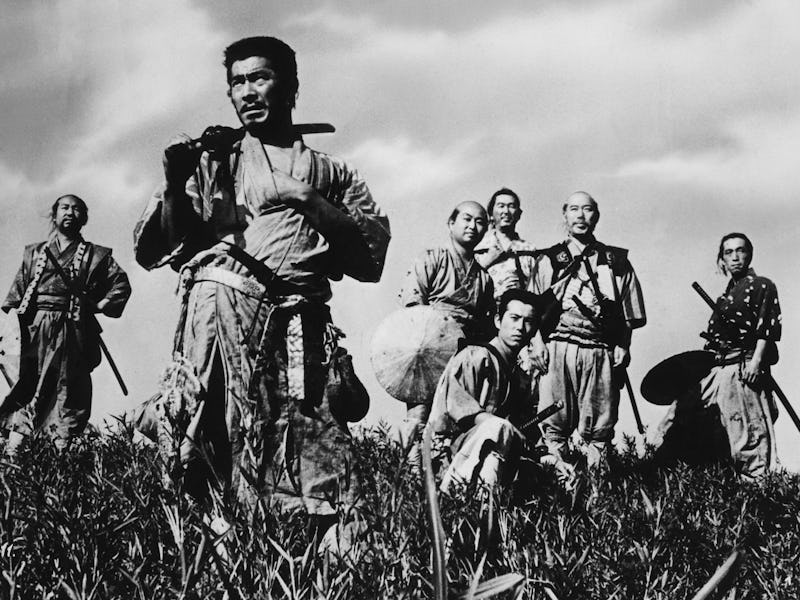Akira Kurosawa’s Masterpiece is Your Favorite Action Movie’s Favorite Action Movie
One of the greatest movies of all time is getting a new 4K release.

For basically as long as Hollywood has existed, it has loved to remake things. Some stories, like A Star Is Born, have been told over and over again for almost a century. Others have been remade, but have also become embedded in the way stories are told in Hollywood more generally.
Akira Kurosawa’s Seven Samurai has been adapted into not one but two different westerns. But that undersells the influence it’s had on hundreds of films since. It tells the story of a band of samurai who assemble to defend a town from bandits. Of course, that set-up in and of itself was not invented with this epic. Seven Samurai is, in many ways, the prototypical example of this kind of story, though, and not least because it’s the very best version of it.
In three extended acts, the film chronicles the assembling of these samurai into a unit, their preparations for battle, and the battle itself. That structure, along with the film’s premise and many of its formal elements, have been hugely influential on action filmmaking in the decades since the film’s release. And now, with its new 4K release from Criterion, Seven Samurai’s influence is more apparent than ever.
The cover of Seven Samurai’s new Criterion release.
The samurai at the center of Seven Samurai are tasked with fighting off a small army of bandits, and the same is true of the soldiers in Saving Private Ryan or the superheroes in The Avengers, except they’re fighting Nazis and aliens instead of bandits. Ocean’s Eleven has almost no tonal similarities to Seven Samurai, but the gradual introduction of each member of the team that Danny Ocean is putting together closely resembles the way Toshiro Mifune’s central samurai slowly recruits the members of his team. Once these disparate warriors are assembled, their clashes and differing perspectives are crucial to the movie’s propulsive sense of plot. These men were brought together for a single reason, which is something they have in common with the central gang in The Dirty Dozen and even the ultra-powered heroes in The Avengers. As it turns out, a ragtag team is exciting both because different people can relate to different characters, and because it can feel almost impossible that they’ll ever actually succeed in their mission.
Beyond the specifics of its interpersonal character dynamics, though, Seven Samurai is also a prime example of the filmmaking style that would eventually infect Hollywood. The film’s rhythms, its relentless pace, and its incredible accessibility are all things that directors like Steven Spielberg and George Lucas would imitate for their Hollywood productions. What’s most remarkable about Seven Samurai is the clarity with which it tells its story. This is a film that juggles more than a dozen primary characters, complex action sequences, and difficult spatial geography, and always keeps the emphasis exactly where it should be.
The Dirty Dozen is just one of many movies that owes its existence to Seven Samurai.
That watchability is crucial to Seven Samurai even before its final, breathtaking hour, but it becomes even more evident when the action really breaks out. It’s here that we see Kurosawa’s utter mastery of space, and the ways that mastery translates into crystal clear visual storytelling. The battle of New York in The Avengers was hugely influenced by the clarity displayed in Seven Samurai, as was something like the Battle of Helms Deep in Lord of the Rings: The Two Towers. These sequences have multiple characters fighting different enemies at the same time, and manage to cut between them or, when possible, create continuity inside of the space between the characters.
This kind of spatial awareness may seem like the most basic possible requirement of compelling action, and in a way that’s true. And, it’s not like Kurosawa invented parallel editing. What’s remarkable about Seven Samurai watching it now, though, is that it feels just like all the action movies that would follow it, often decades later.
That can mean that actually watching Seven Samurai can feel like consuming trope after trope. Of course, tropes are only annoying to the viewer if they’re poorly executed, and that certainly isn’t the case for Seven Samurai. What’s also crucial to understand, though, is that when Seven Samurai did so many of these things, they weren’t yet tropes. They were invented or perfected by this movie and adopted by generations of other titles afterwards.
Seven Samurai is an inarguable classic.
Seven Samurai is one of the most influential movies ever made. It’s a riveting action adventure that delivers exactly what you might expect from the premise. The film’s direction, its plotting, its character dynamics, and everything else about it has been imitated by generations of other directors, so much so that you might recognize Seven Samurai even if you’ve never actually seen it.
The ultimate miracle of Seven Samurai, though, is that the movie is still incredible in spite of all this. It might have inspired dozens of other movies, but Seven Samurai can still match the achievement of anything that followed it. Akira Kurosawa was just that good.